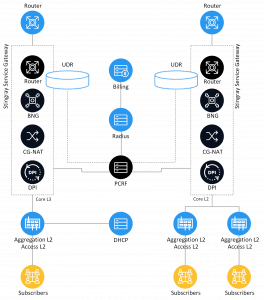
Its main innovation is routing support, based on router daemons (background service software) in a separate space of VRF names.
The main advantages of the new release are:
- simplicity of scaling. From now on, when using Stingray as BRAS, it is possible to divide a load among several nodes and to achieve the necessary performance. Let us remind: usage of 64 core CPU allows processing up to 100G full-duplex per server.
- simplified redundancy. If several nodes are in use, there is the possibility to switch traffic to failover equipment with minimal delays and connection breaks.
- BIRD router daemon support. Operating with FRRouting (FRR), QUAGGA, Juniper CRPD, and other daemons is in further development plans.
BIRD acts as the broker: setting the routing protocol, exchanging routing information, compiling the routing table, and, via Linux Kernel, transmitting it to fastDPI control module. This way synchronization between BIRD and fastDPI occurs.
Artem Tereschenko, VAS Experts Partnership manager:
«Stingray SG new release is different from the previous one: all VLAN (L2 domains) pass to both nodes. They might operate in Active and Passive modes, as well as in balancing mode. After DPI receives ARP, DHCP, or PPPOE packet, it performs authorization and, upon its success, starts the subscriber’s routing transmission via OSPF/BGP to a router. If nat pool is initiated, at the moment of its creation DPI starts announcing the white subnet information for a router.
The router operates on separate: both thread and CPU core. At launch, the system applies default thread parameters – that might be modified in the future. Special note: router adds to memory requirements – on average one should have 160 GB or more for reliable operations.
Taking into consideration that Stingray is the DPI system first of all (which assumes operations in BRIDGE mode) – routing support is the big step forward, new possibilities uncovered».
Architecture of the solution:

Work on new functionalities – operations with several IN and OUT interfaces, Switching, balancing mode for Active-Active redundancy scheme, and more – is already in progress.
The new release is already available. If you are willing to use it – VAS Experts tech. support is ever ready to accept your notes and suggestions on functionality.